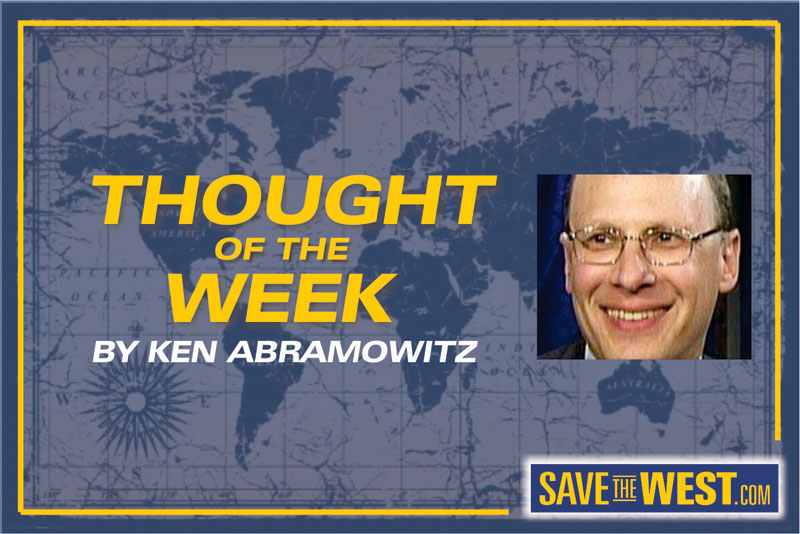.

By Ken Abramowitz and Jon Sutz
Ken Abramowitz is the President and Founder of SaveTheWest. Jon Sutz is SaveTheWest’s consulting editor and videographer. See Ken’s previous editorial on the prospect of achieving a peaceful solution to the US-Iran conflict: Ken’s Thought of the Week: Forging an Iranian Policy.
Today’s world population of over 7 billion people is divided approximately 50/50 between democracies and dictatorships.
When disputes arise between democracies, negotiations take place, and resolutions are found, usually in a timely manner.
When disputes arise among dictatorships, however, issues are usually resolved by force — or the threat of force.
But how do democracies and dictatorships resolve their disputes? Often, poorly, with two relatively recent exceptions, namely World War 2 and the Cold War. The huge resolve of the U.S. public and leadership in WW2 was aided by the trauma of Pearl Harbor.
The Cold War was aided by the lingering trauma of WW2, and the public’s realization that both the U.S. and U.S.S.R. were armed with enough atomic weapons to destroy each other, and the entire world, many times over.
Both WW2 and the Cold War ended with America being victorious.
The Korean War, however, was fought to a stalemate, and Vietnam was America’s first strategic loss (actually a psychological loss, the result of domestic subversion, stoked and aided by Vietnamese and Chinese propagandists, as they later admitted).
Contrary to the protestations voiced to this day by its architects, and major media entities that used lies and deception to help them, the 2015 Joint Comprehensive Plan of Action (JCPOA) with Iran led to an American loss, for three key reasons:
(1) Contrary to President Obama’s promise to the American people in 2012, that he would only accept a deal that requires Iran to completely dismantle its nuclear program, he instead gave them the right to build nuclear weapons ten years after the “deal” commenced. Knowing this, he then lied to the American people, in the fall of 2015, by falsely claiming that his deal “cut off all avenues to a nuclear weapons.”
During the second 2012 presidential debate, President Obama promised the American people that if they re-elected him, he would only accept a deal with Iran that requires the complete dismantling of its nuclear program. Here is the transcript, and video:
Bob Schieffer (moderator): “As you know, there are reports that Iran and the United States a part of an international group, have agreed in principle to talks about Iran’s nuclear program. What is the deal, if there are such talks? What is the deal that you would accept, Mr. President?
Obama: “[O]ur goal is to get Iran to recognize it needs to give up its nuclear program and abide by the U.N. resolutions that have been in place. [T]he deal we’ll accept is they end their nuclear program. It’s very straightforward.”
The reality is, as the nonpartisan Institute for Science and International Security reports (highlights added)
Advocating for re-entry means supporting and providing international legitimacy to the provision in the JCPOA that allows Iran to start building up its industrial infrastructure to manufacture advanced gas centrifuges that enrich uranium beginning in 2023, or during the next presidential term. Iran is scheduled to start deploying an ever-increasing number of advanced centrifuges starting in 2025, as envisioned under Iran’s long-term enrichment plan developed alongside the JCPOA. Advocates may not be aware that these developments directly reduce Iran’s nuclear weapons breakout timeline, or the time it would take Iran to produce enough weapon-grade uranium for a nuclear weapon. This ignores the fact that, to date, Iran has been unable to produce any economic or otherwise credible non-military, civilian justification for its uranium enrichment program; instead, this program continually poses a threat to regional peace and stability.
Further, as the scholar Dr. Mitchell Bard pointed out on July 17, 2019, in “The Iran Deal Hoax” (emphasis added):
German intelligence has found that Iran has continued to seek weapons of mass destruction.
In addition, as feared by critics of the deal, the IAEA was unaware of Iran’s ongoing nuclear program and therefore did not know what to inspect. It was only after Israeli intelligence discovered Iran’s secret trove of documents that we learned the Iranians had preserved the documentation needed to resume their program when the deal expired.
Then, more dramatically, on September 27, 2018, Israeli Prime Minister Benjamin Netanyahu revealed the existence of a secret warehouse in the Turquz Abad district in Tehran, which he said held equipment and materiel related to Iran’s past or possibly ongoing nuclear weapons efforts. He also disclosed that the facility had held 15 kilograms of radioactive material that Iran subsequently dispersed around Tehran.
“The IAEA’s lack of action or explanation of its inaction undermines its credibility and raises questions about its effectiveness in its Iran safeguards mission,” Olli Heinonen, former Deputy Director General of the IAEA and head of its Department of Safeguards, said after Netanyahu’s revelations.
(2) President Obama gave Iran the right to continue building intercontinental ballistic missiles (ICBMs) with which to deliver nuclear weapons to the U.S., Europe and other Western allies.
The Obama administration either actively denied this to be the case, or skirted around the issue, until January 3, 2019. That’s when Iranian Foreign Minister Javad Zarif posted this Tweet, in which he informed the world of the actual terms of the JCPOA — and that according to Iran, the U.S. and its allies were powerless, under the terms of the agreement, to stop it from building and testing ICBMs:
(3) President Obama did not insist that there be a mechanism in place by which to ensure that not a penny of the estimated $150 billion in cash that he and U.S. allies were going to release to Iran under the JCPOA would be used to continue funding its worldwide terrorist operations. As a result, that is exactly what happened: Iran has been on a worldwide terrorist-funding spree.
Speaking on behalf of President Obama, then-Secretary of State John Kerry, a major player in “negotiating” the deal, assured the American people that the U.S. government would work diligently to ensure that this money would not be used to fund terrorism:
The reality is that if we trusted Iran or thought that it was about to become more moderate, this agreement would be less necessary than it is. But we don’t. We would like nothing more than to see Iran act differently, but not for a minute are we counting on it. […] We work with Israel every day to enforce sanctions and prevent terrorist organizations such as Hamas and Hizballah from obtaining the financing and the weapons that they seek – whether from Iran or from any other source. And we will stand with Israel to stop its adversaries from once again launching deadly and unprovoked attacks against the Israeli people.
The reality, as documneted out by the left-leaning Brookings Institution, is that the money released to Iran primarily benefited two groups: (a) Hezbollah, the world’s largest Islamist terrorist organization, which Brookings calls “Iran’s most successful export,” and (b) the Iranian Revolutionary Guard Corps (IRGC), its domestic terrorist organization.
This was further validated by when Hezbollah’s leader, Hasan Nasrallah, openly admitted — almost one year after the implementation of the JCPOA — that 100% of the terror group’s funding comes from Iran. Hamas officials have repeatedly made similar boasts in the past.
Since then Iran has been on a worldwide spending spree, from funding the conversion of U.S. mosques and Muslim cultural centers into “terror command centers.” to the Houthi terrorists in Yemen, and operatives who were recently caught operating a massive bomb-making facility in London, England.
This cartoon, by Michael Ramirez, accurately sums up the situation in which we found ourselves upon commencement of the JCPOA, even though it took time for the reality to seep out, beyond the ability of the “echo chamber” that the Obama White House constructed to stop it. (For those who don’t know, Iran’s “Supreme Leader” Khamanei was leading public chants of “Death To America!!!” on video — as he was “negotiating” the “deal” with President Obama.)
Current re-negotiations between the U.S. and Iran have yet to commence publicly, but will inevitably lead to a loss by the U.S., unless our resolve strengthens materially.
Our negotiations with Venezuela and North Korea are stalemated, and can go either way.
Similarly, our negotiations with the Taliban in Afghanistan are going poorly, and appear leading to an American defeat, propelled by the Trump administration’s determination to wind down U.S. involvement after nearly 20 years.
So what is the key message? It is that democracies are economically and physically stronger than dictatorships. Therefore, democracies can defeat their dictatorship enemies whenever they want to, if they can maintain the determination to win over long periods of time.
But if there is inadequate public education, however, as we saw in the Vietnam conflict, democratic governments can quickly lose both their resolve, and their will to insist on victory. At that time, democratic governments switch their goal to managing, which inevitably leads to a loss.
Let’s hope our government maintains its resolve, and leads us from victory to victory.
We can only hope that the U.S. and other democracies will win, and the downtrodden population of the dictatorships will also win, by finally being able to have a chance to build free (or at least freer) nations. The only losers would be the dictators. And that’s the way it should be.
Additional reading
VIDEO: Pearl Harbor Disaster for Japan – National Geographic
The Only Live News Report from the Attack on Pearl Harbor – Smithsonian Institution
VIDEO: Attack on Pearl Harbor 1941
The Korean War: Years of Stalemate – US Army Center of Military History
Saigon’s Fall Still Echoes Today – Wall St. Journal
The Rhodes To HuffPost – Save The West
Joint Plan of Action (JPOA) Archive and Joint Comprehensive Plan of Action (JCPOA) Archive
Opportunity for a New Iran Nuclear Deal – Institute for Science and International Security
Major beneficiaries of the Iran deal: The IRGC and Hezbollah – Brookings Institution
Hezbollah: Revolutionary Iran’s most successful export – Brookings Institution
In first, Hezbollah confirms all financial support comes from Iran – Al Arabiya English
Iran Admits Supporting Houthis, Holds onto ‘Hezbollah’s’ Arms – Asharq AL-awsat
The Iran Deal Hoax | Jewish & Israel News Algemeiner.com
The Secret History of the Iran-Deal ‘Echo Chamber’ – Bloomberg
REPORT: Iran Is Turning US Mosques Into ‘Terror Command Centers’ On American Soil
.
.
.







